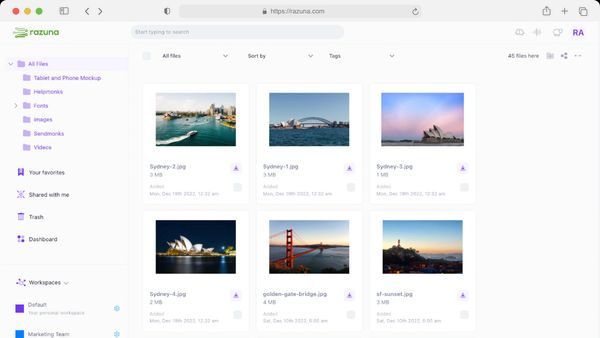
10 Top Enterprise File-Sharing Solutions
Discover the top enterprise file-sharing solutions for secure, efficient collaboration. Learn what to look for in an file-sharing solution and find the best fit.
Read nowAre you ready to unlock the potential of an asset management strategy? This guide is your key to streamlining asset distribution, boosting financial efficiency, and ensuring your business is complying with legal requirements.
Having a clear grasp of all the assets under your control is crucial to the success of your organization. You'll need to know their costs, their lifespans, and how well they perform for the benefit of your company.
Once you're equipped with this knowledge, creating a management strategy can help you identify under performing assets and make a plan to optimize them.
Read on to find out all about asset management strategies, their benefits, and how to create one!
To understand what an asset management strategy is, you first need to understand what assets are.
Assets are anything of value that your organization owns or controls. They can be physical, like machinery and real estate, or intangible, like intellectual property, digital assets, brand assets, and goodwill.
Your asset management strategy is how you deploy, operate, maintain, upgrade, and dispose of assets. It will help you manage your business assets most cost-effectively. Your strategy should include:
Identifying assets: Recognizing and cataloging what you have.
Assessing performance: Analyzing how well these assets contribute to your business goals.
Cost management: Tracking the cost of managing your available assets.
Risk mitigation: Planning for potential challenges and uncertainties.
You can think of this strategic plan as a roadmap that ensures all your assets are working to the benefit of your organization.
You've worked hard to acquire your assets, but are they helping you achieve your business goals? Are they adding value to your operations?
Only when you have a good management strategy can you enjoy the following benefits:
An asset management strategy enhances efficiency by streamlining the handling of assets. Instead of delays caused by manual tracking and scheduling, the strategy lets you monitor assets and maintain them regularly.
This means you can spend less time on administrative tasks and focus more on productive activities. The result is a smoother workflow, fewer interruptions, and a more agile response to the needs of your organization.
Optimizing asset utilization is about making the best use of what you have. An asset management strategy lets you use every tangible or intangible asset to its full potential. Maximum utilization involves regular monitoring, timely maintenance, and strategic deployment.
When you understand the condition and performance of your assets, you can allocate them where you need them most. As a result, you reduce downtime and maximize output.
You can save money by proactively monitoring and maintaining your assets.
Without a good strategy, you might face unexpected breakdowns or encounter digital asset corruption and compatibility issues. These problems will often require costly repairs.
Having a good digital asset management (DAM) strategy in place streamlines processes, reducing manual tasks and the need to recreate misplaced assets.
For your physical assets, an asset management strategy helps you schedule regular maintenance checks, catching issues before they become costly.
This results in time and cost savings across your organization.
A good asset management strategy ensures you comply with regulations by aligning your operations with legal requirements and industry standards.
It involves continuous monitoring, knowing the regulations for each asset, and taking steps to follow them. Doing so helps you avoid penalties and fines and builds trust with regulators and stakeholders.
When you have an asset management strategy, you can improve your decision-making process. You'll be able to gather clear insights into the state and performance of your assets.
You can then make informed choices about maintenance, upgrades, replacements, and retirements by analyzing data and trends.
A good strategy allows you to allocate resources effectively, plan for future needs, and respond to changes promptly.
Think of your asset management strategy as the lock on a treasure chest. It strengthens the security of your assets through meticulous tracking and control measures.
You'll have a system to monitor location, condition, and access, whether for physical equipment or sensitive data. Your digital assets will be stored securely and regularly backed up, ensuring data integrity.
This minimizes the risk of theft, loss, or unauthorized use, safeguarding against potential vulnerabilities.
Risk management in an asset management strategy involves identifying, evaluating, and eliminating possible threats to your assets.
By monitoring the condition and performance of your assets, you can predict potential issues and take preventive measures.
This minimizes disruptions to your operations, prevents safety hazards, and protects your organization's reputation.

Now that you know the benefits of an asset management strategy, it's time to create your own. This step-by-step plan will make sure your assets work well and stay valuable throughout their lifecycle.
Here's how to create your strategy:
This step involves identifying what you want to achieve with your assets and aligning them with your organization's mission and vision. Whether improving efficiency, reducing costs, enhancing security, or complying with regulations, your goals set the direction for the entire strategy.
When you understand what success looks like for your organization, you can tailor your asset management approach to meet those needs. This is a foundational step that ensures every subsequent decision and action is purpose-driven.
In this step, you'll examine all the assets within your organization.
You'll need to catalog your assets to understand their current condition, value, and relevance. Once you have an inventory, you can start evaluating the performance of each asset.
For physical assets, this could mean measuring the life expectancy and efficiency of your machinery. For digital assets, you could evaluate their integrity and compatibility.
This detailed assessment will provide a clear picture of where you stand, highlighting strengths, weaknesses, opportunities, and threats related to your assets.
After assessing your inventory, it's time to organize it into categories, such as function, importance, or risk level.
Categorizing helps manage assets more efficiently, as identical assets often have similar management needs. Then, you prioritize them based on factors like criticality to operations, potential risks, or alignment with organizational goals.
Doing so ensures you focus your attention and resources on the most critical assets. It guides decision-making, investment, and maintenance efforts, ensuring critical assets receive extra care and attention.
This stage is about understanding how your assets perform, their maintenance history, usage patterns, and other vital statistics. You can use tools and technologies to automate data collection and provide real-time insights for your assets.
When you analyze your data, you uncover patterns, trends, and potential areas for improvement.
Once you've collected and analyzed the data, you can examine areas where vulnerabilities, uncertainties, or threats may exist. It could be the risk of equipment failure, compliance issues, security breaches, or financial uncertainties related to asset investments.
Once you've pinpointed where risks may lie, you can predict their potential impact on your organization. Then, you can develop plans and measures to manage those risks.
This involves mapping out the lifespan of each asset - from acquisition and use to maintenance, upgrading, and eventual disposal or replacement.
Planning the lifecycle means understanding how each asset fits into your strategy at different stages of its life. It includes scheduling regular maintenance to ensure optimal performance. You also need to plan upgrades to enhance functionality and determine when it's time to retire or replace an asset.
Alongside lifecycle planning, budgeting is essential. You'll allocate financial resources to support each stage of the asset's life, considering both immediate costs and long-term investments. This includes budgeting for routine maintenance, unexpected repairs, upgrades, and replacements.
Monitoring and improving is an ongoing process that ensures your strategy's continued success and relevance.
Monitoring involves regularly reviewing the performance, condition, and costs of your assets. You'll track how well they align with your goals to identify deviations or challenges.
Using performance metrics, key performance indicators (KPIs), and regular audits can provide valuable insights into your assets' performance.
Improvement is the natural progression from monitoring. Based on the insights, you'll identify opportunities to enhance efficiency, reduce costs and risks, or optimize your asset management approach. This might involve adjusting maintenance schedules, reallocating resources, updating risk management plans, or revising budgets.
When you regularly evaluate and adjust your approach, you'll ensure that your strategy remains effective, responsive, and aligned with your goals. This is the key to long-term success for your organization.
Developing an asset management strategy is a comprehensive process that aligns your organization's assets with its overarching goals. From defining objectives to monitoring and continuous improvement; each step is integral to creating a strategy that maximizes efficiency, cost savings, security, and risk management.
To create and maintain a good strategy, we recommend getting a tool that will make your processes quick and easy. To take care of all your digital assets, try Razuna! It offers a robust, cost-effective, and adaptable cloud-based digital asset management solution to help your business thrive.
Book a demo today!

Discover the top enterprise file-sharing solutions for secure, efficient collaboration. Learn what to look for in an file-sharing solution and find the best fit.
Read now
What is digital asset storage? This guide to digital asset storage has all the answers. Learn how to implement digital asset storage for all your teams.
Read now
All files that your business uses is a type of digital asset. This guide explains the various types, what makes them crucial, and how best to manage them.
Read now
A digital asset management strategy is essential for your brand. This guide explores how to maximize your brand's potential with this powerful combination.
Read now
(each free accounts comes with 500 GB space)
